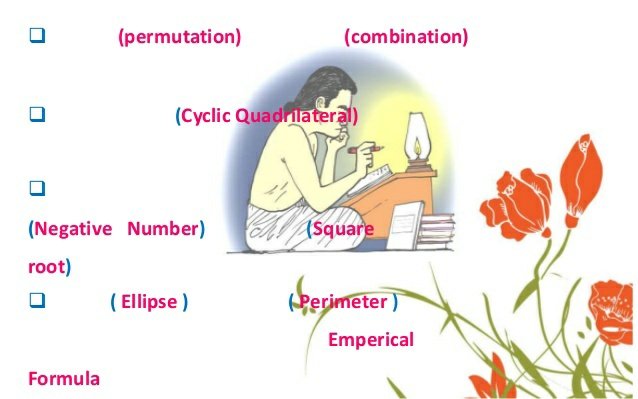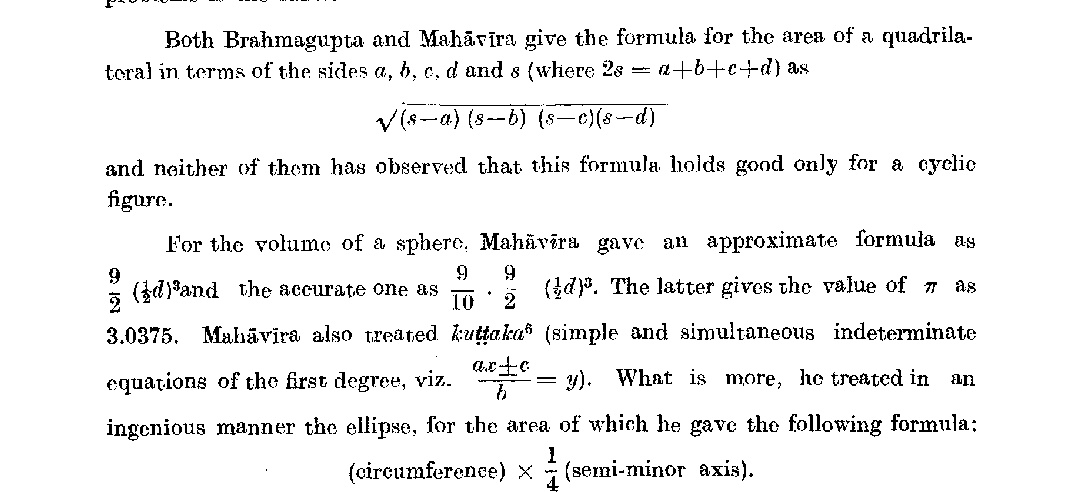https://t.co/hXlo8qgkD0
Look like that they got a classical case of PCR Cross-Contamination.
They had 2 fabricated samples (SRX9714436 and SRX9714921) on the same PCR run. Alongside with Lung07. They did not perform metagenomic sequencing on the “feces” and they did not get

Human+Mouse in the positive SRA, human in both of them. Seeing human+mouse in identical proportions across 3 different sequencers (PRJNA573298, A22, SEX9714436) are pretty straight indication that the originals

X-ray tests revealed a large area of shadow in the left lung of pangolin 2-Lishui, suggestive of pneumonia” but

M1 have Murine Respirovirus.
https://t.co/ZJnLSxwe5o
SeV is in the same family as human Parainfluenza virus. It causes bilateral ground-glass opacity.
https://t.co/NeY2ajwsDo

More from Daoyu
@franciscodeasis https://t.co/OuQaBRFPu7
Unfortunately the "This work includes the identification of viral sequences in bat samples, and has resulted in the isolation of three bat SARS-related coronaviruses that are now used as reagents to test therapeutics and vaccines." were BEFORE the

chimeric infectious clone grants were there.https://t.co/DAArwFkz6v is in 2017, Rs4231.
https://t.co/UgXygDjYbW is in 2016, RsSHC014 and RsWIV16.
https://t.co/krO69CsJ94 is in 2013, RsWIV1. notice that this is before the beginning of the project
starting in 2016. Also remember that they told about only 3 isolates/live viruses. RsSHC014 is a live infectious clone that is just as alive as those other "Isolates".
P.D. somehow is able to use funds that he have yet recieved yet, and send results and sequences from late 2019 back in time into 2015,2013 and 2016!
https://t.co/4wC7k1Lh54 Ref 3: Why ALL your pangolin samples were PCR negative? to avoid deep sequencing and accidentally reveal Paguma Larvata and Oryctolagus Cuniculus?
Unfortunately the "This work includes the identification of viral sequences in bat samples, and has resulted in the isolation of three bat SARS-related coronaviruses that are now used as reagents to test therapeutics and vaccines." were BEFORE the

chimeric infectious clone grants were there.https://t.co/DAArwFkz6v is in 2017, Rs4231.
https://t.co/UgXygDjYbW is in 2016, RsSHC014 and RsWIV16.
https://t.co/krO69CsJ94 is in 2013, RsWIV1. notice that this is before the beginning of the project
starting in 2016. Also remember that they told about only 3 isolates/live viruses. RsSHC014 is a live infectious clone that is just as alive as those other "Isolates".
P.D. somehow is able to use funds that he have yet recieved yet, and send results and sequences from late 2019 back in time into 2015,2013 and 2016!
https://t.co/4wC7k1Lh54 Ref 3: Why ALL your pangolin samples were PCR negative? to avoid deep sequencing and accidentally reveal Paguma Larvata and Oryctolagus Cuniculus?
@danwalker9999 https://t.co/o8zqouq0HB
Bias, however, is an important problem in the WHO data. Also, an important problem seen in the points being scattered around is that they seems to be pulled toward the Huanan market—it was likely that it was used as the point of origin for the coordinate
System used. https://t.co/KnPRvIN8uK At this level of imprecision, it becomes impossible ti distinguish the Huanan market, the Wuhan CDC, and the Hankou railway station—the last of which is the main transport hub in Wuhan and the only transport hub reachable from the WIV within

1 transfer on the metro system. Cases “unlinked” were mainly clustered north of the Hankou station—which was one of the major exits through the hankou station and one of the transfer stations next to the Hankou railway station. Even connor reed, which is on the east of the
Yangtze river, supposedly have onset in November 2019 (whistleblower case #2), was connected to the WIV directly—it was on the same metro line, line 8, as the WIV. As he is an education worker, he need to commute to Wuchang where the universities are—exposing him to the WIV
Every time he takes line 8 to commute. https://t.co/5TIqOjt2p1
In addition to enforced ascertainment bias toward the market with a retrospective case search that specifically targeted the immediate surrounding of Huanan market, symptomology bias with lineage B created an
Bias, however, is an important problem in the WHO data. Also, an important problem seen in the points being scattered around is that they seems to be pulled toward the Huanan market—it was likely that it was used as the point of origin for the coordinate
System used. https://t.co/KnPRvIN8uK At this level of imprecision, it becomes impossible ti distinguish the Huanan market, the Wuhan CDC, and the Hankou railway station—the last of which is the main transport hub in Wuhan and the only transport hub reachable from the WIV within

1 transfer on the metro system. Cases “unlinked” were mainly clustered north of the Hankou station—which was one of the major exits through the hankou station and one of the transfer stations next to the Hankou railway station. Even connor reed, which is on the east of the
Yangtze river, supposedly have onset in November 2019 (whistleblower case #2), was connected to the WIV directly—it was on the same metro line, line 8, as the WIV. As he is an education worker, he need to commute to Wuchang where the universities are—exposing him to the WIV
Every time he takes line 8 to commute. https://t.co/5TIqOjt2p1
In addition to enforced ascertainment bias toward the market with a retrospective case search that specifically targeted the immediate surrounding of Huanan market, symptomology bias with lineage B created an
@AngloScot2 @WisdomRebel https://t.co/iHKwUoNLJ5
https://t.co/sxm17Eu9hV
https://t.co/FtjifSGItc
PRRA is highly purified in the CaLu-3 cell line when FBS is added to inhibit trypsin. Stu lied about that in his defense on the FCS identity. https://t.co/GzM7uA6vup the Gallaher article contain glaring
@WisdomRebel Mistakes and is completely impossible as HKU9 + RaTG13 only lead to a frameshift inactivated S and not a furin cleaved S.
https://t.co/gmDXK9OluN
The serological test the WIV claimed to be negative in Shi’s addendum is the exact same test they claimed positive in 2012 in the phD
@WisdomRebel thesis, and Stu once again lied about it. https://t.co/Uiy8U9BTYp significant evidence in the form of contaminated SRA datasets suggest that the DEFUSE grant have been funded in China, as the full-length HKU4 is not a part of the 2016-2019 grant, but is found before the start
@WisdomRebel Date of the 2020-2024 grant of June 2020. The WIV also contained several HKU3-like Coronaviruses, particularly in mice in an 2017 GEO experiment, which is consistent with the published HKU3 and batified mice experiment in the DEFUSE document (evidence from an already conducted
@WisdomRebel Experiment). Either DEFUSE or fast-tracked form of the 2020-2024 grant in 2019 would have lead to full-length Sarbecovirus clones being used, leading to SARS-CoV-2 in the lab—they used HKU4 in stead of HKU5 for the MERS spike experiment indicating that backbone sequence distance
https://t.co/sxm17Eu9hV
https://t.co/FtjifSGItc
PRRA is highly purified in the CaLu-3 cell line when FBS is added to inhibit trypsin. Stu lied about that in his defense on the FCS identity. https://t.co/GzM7uA6vup the Gallaher article contain glaring
@WisdomRebel Mistakes and is completely impossible as HKU9 + RaTG13 only lead to a frameshift inactivated S and not a furin cleaved S.
https://t.co/gmDXK9OluN
The serological test the WIV claimed to be negative in Shi’s addendum is the exact same test they claimed positive in 2012 in the phD
@WisdomRebel thesis, and Stu once again lied about it. https://t.co/Uiy8U9BTYp significant evidence in the form of contaminated SRA datasets suggest that the DEFUSE grant have been funded in China, as the full-length HKU4 is not a part of the 2016-2019 grant, but is found before the start
@WisdomRebel Date of the 2020-2024 grant of June 2020. The WIV also contained several HKU3-like Coronaviruses, particularly in mice in an 2017 GEO experiment, which is consistent with the published HKU3 and batified mice experiment in the DEFUSE document (evidence from an already conducted
@WisdomRebel Experiment). Either DEFUSE or fast-tracked form of the 2020-2024 grant in 2019 would have lead to full-length Sarbecovirus clones being used, leading to SARS-CoV-2 in the lab—they used HKU4 in stead of HKU5 for the MERS spike experiment indicating that backbone sequence distance
More from Science
JUST ONE PERSON—UK 🇬🇧 scientists think one immunocompromised person who cleared virus slowly & only partially wiped out an infection, leaving behind genetically-hardier viruses that rebound & learn how to survive better. That’s likely how #B117 started. 🧵 https://t.co/bMMjM8Hiuz
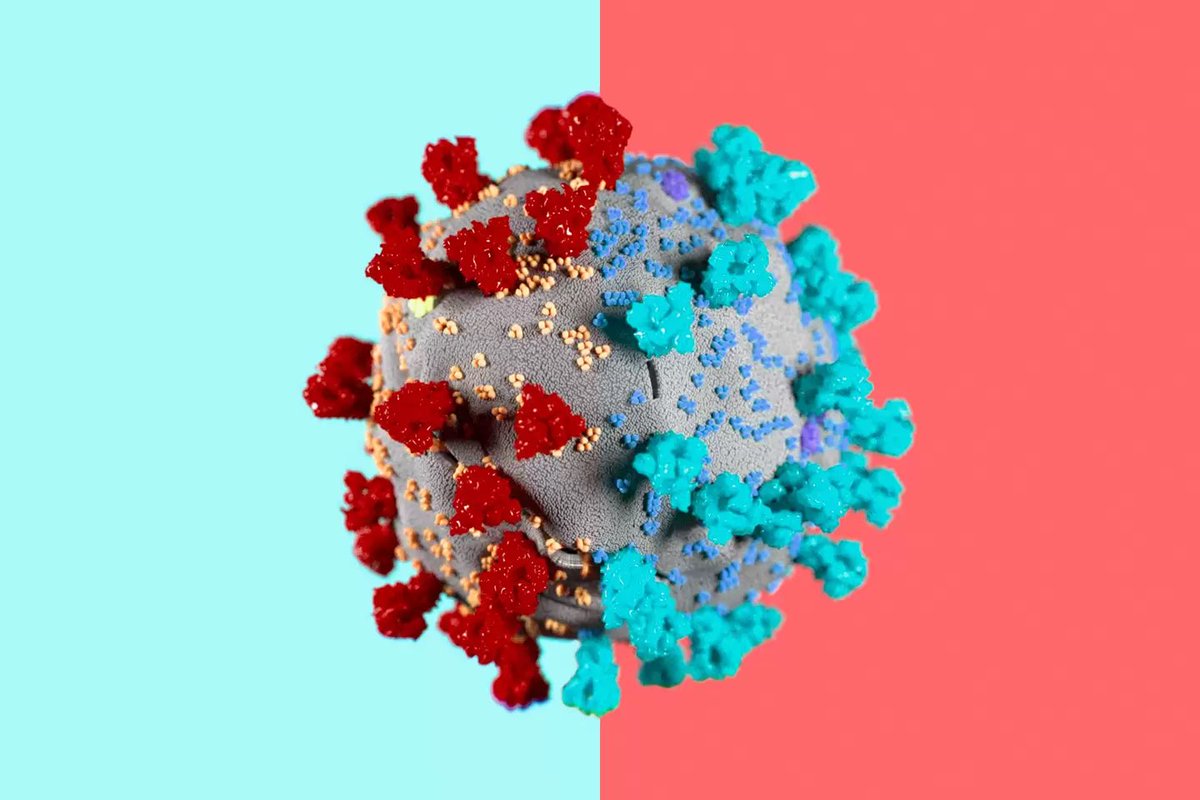
2) The leading hypothesis is that the new variant evolved within just one person, chronically infected with the virus for so long it was able to evolve into a new, more infectious form.
same thing happened in Boston in another immunocompromised person that was sick for 155 days.
3) What happened in Boston with one 45 year old man who was highly infectious for 155 days straight before he died... is exactly what scientists think happened in Kent, England that gave rise to #B117.
4) Doctors were shocked to find virus has evolved many different forms inside of this one immunocompromised man. 20 new mutations in one virus, akin to the #B117. This is possibly how #B1351 in South Africa 🇿🇦 and #P1 in Brazil 🇧🇷 also evolved.
5) “On its own, the appearance of a new variant in genomic databases doesn’t tell us much. “That’s just one genome amongst thousands every week. It wouldn’t necessarily stick out,” says Oliver Pybus, a professor of evolution and infectious disease at Oxford.

2) The leading hypothesis is that the new variant evolved within just one person, chronically infected with the virus for so long it was able to evolve into a new, more infectious form.
same thing happened in Boston in another immunocompromised person that was sick for 155 days.
3) What happened in Boston with one 45 year old man who was highly infectious for 155 days straight before he died... is exactly what scientists think happened in Kent, England that gave rise to #B117.
Immunocompromised 45 year old suffered from #COVID19 for 155 days before he died. The virus was changing very quickly inside the man's body\u2014it acquired a big cluster of >20 mutations\u2014resembled the same ones seen in #B117 & #B1351. (NPR audio Part 1 of 2)\U0001f9f5https://t.co/7kWiBZ1xGk pic.twitter.com/ZJ7AExB78Y
— Eric Feigl-Ding (@DrEricDing) February 8, 2021
4) Doctors were shocked to find virus has evolved many different forms inside of this one immunocompromised man. 20 new mutations in one virus, akin to the #B117. This is possibly how #B1351 in South Africa 🇿🇦 and #P1 in Brazil 🇧🇷 also evolved.
2) NPR report audio part 2 of 2:
— Eric Feigl-Ding (@DrEricDing) February 8, 2021
Dr. Li couldn't believe what they found. "I was shocked," he says. "When I saw the virus sequences, I knew that we were dealing with something completely different and potentially very important." pic.twitter.com/HT3Yt6djFd
5) “On its own, the appearance of a new variant in genomic databases doesn’t tell us much. “That’s just one genome amongst thousands every week. It wouldn’t necessarily stick out,” says Oliver Pybus, a professor of evolution and infectious disease at Oxford.
It's another stunning Malagasy #dartfrog/#poisonfrog for today's #FrogOfTheDay, #42 Mantella cowani Boulenger, 1882! A highly threatened, actively conserved and managed frog from the highlands of central #Madagascar
#MadagascarFrogs
📸D.Edmonds/CalPhotos
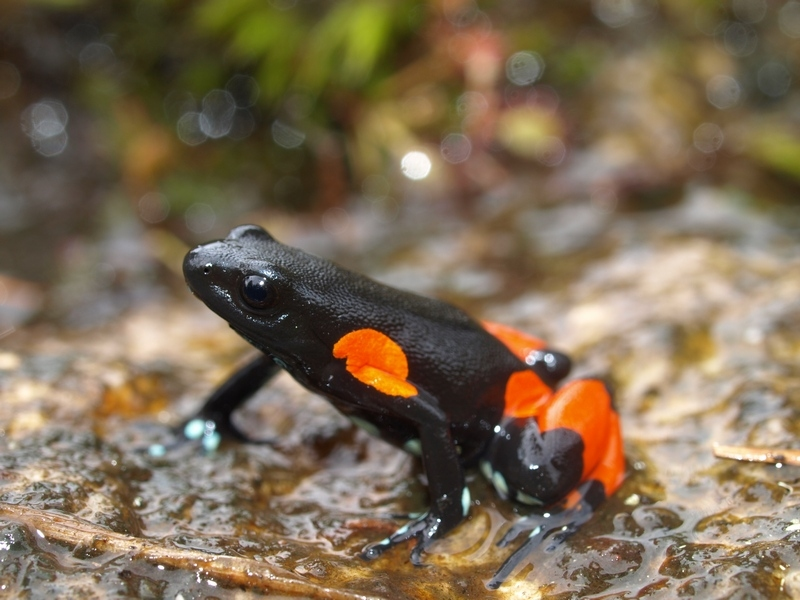
This thread will cover only a tiny fraction of the work on Mantella cowanii because, being so charismatic and threatened, it has received quite a bit of attention.
#MadagascarFrogs
We start at the very beginning: the first specimens, two females, were collected by Reverend Deans Cowan in East Betsileo, Madagascar, and sent to London, where George Albert Boulenger described the species in 1882.
#MadagascarFrogs
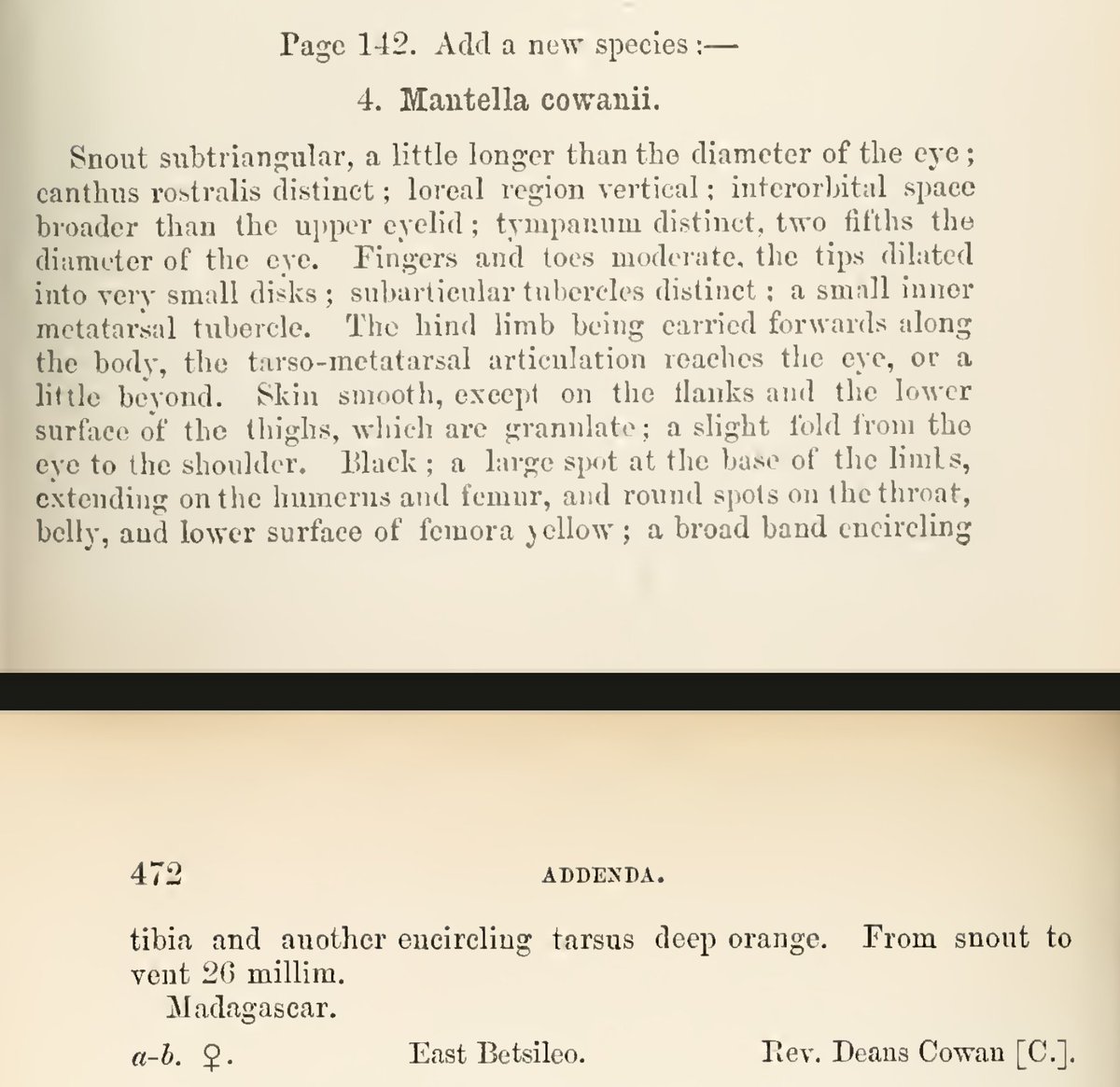
Boulenger placed the species in his new genus, Mantella, along with ebenaui, betsileo, and madagascariensis. He recognised that the other Malagasy poison frogs were distinct from the Dendrobates of the Americas, although he did keep them in the Dendrobatidae.
#MadagascarFrogs
As more specimens were collected, it became clear that the species was highly variable. In 1978, Jean Guibé wrote with interest about this variability, describing a new subspecies, M. cowani nigricans—today a full species. #MadagascarFrogs
https://t.co/dwaHMbrYbj
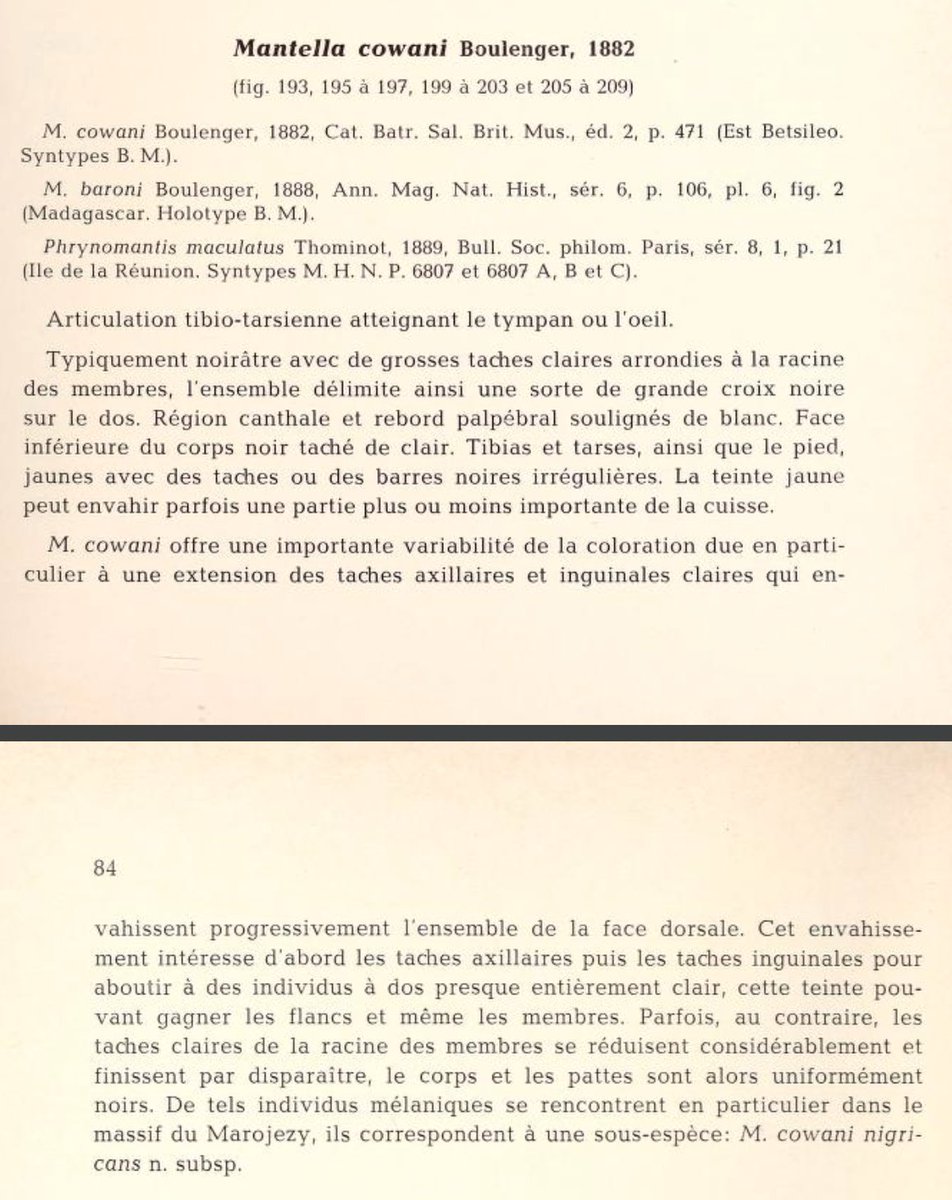
#MadagascarFrogs
📸D.Edmonds/CalPhotos

This thread will cover only a tiny fraction of the work on Mantella cowanii because, being so charismatic and threatened, it has received quite a bit of attention.
#MadagascarFrogs
We start at the very beginning: the first specimens, two females, were collected by Reverend Deans Cowan in East Betsileo, Madagascar, and sent to London, where George Albert Boulenger described the species in 1882.
#MadagascarFrogs

Boulenger placed the species in his new genus, Mantella, along with ebenaui, betsileo, and madagascariensis. He recognised that the other Malagasy poison frogs were distinct from the Dendrobates of the Americas, although he did keep them in the Dendrobatidae.
#MadagascarFrogs
As more specimens were collected, it became clear that the species was highly variable. In 1978, Jean Guibé wrote with interest about this variability, describing a new subspecies, M. cowani nigricans—today a full species. #MadagascarFrogs
https://t.co/dwaHMbrYbj

You May Also Like
1. Project 1742 (EcoHealth/DTRA)
Risks of bat-borne zoonotic diseases in Western Asia
Duration: 24/10/2018-23 /10/2019
Funding: $71,500
@dgaytandzhieva
https://t.co/680CdD8uug
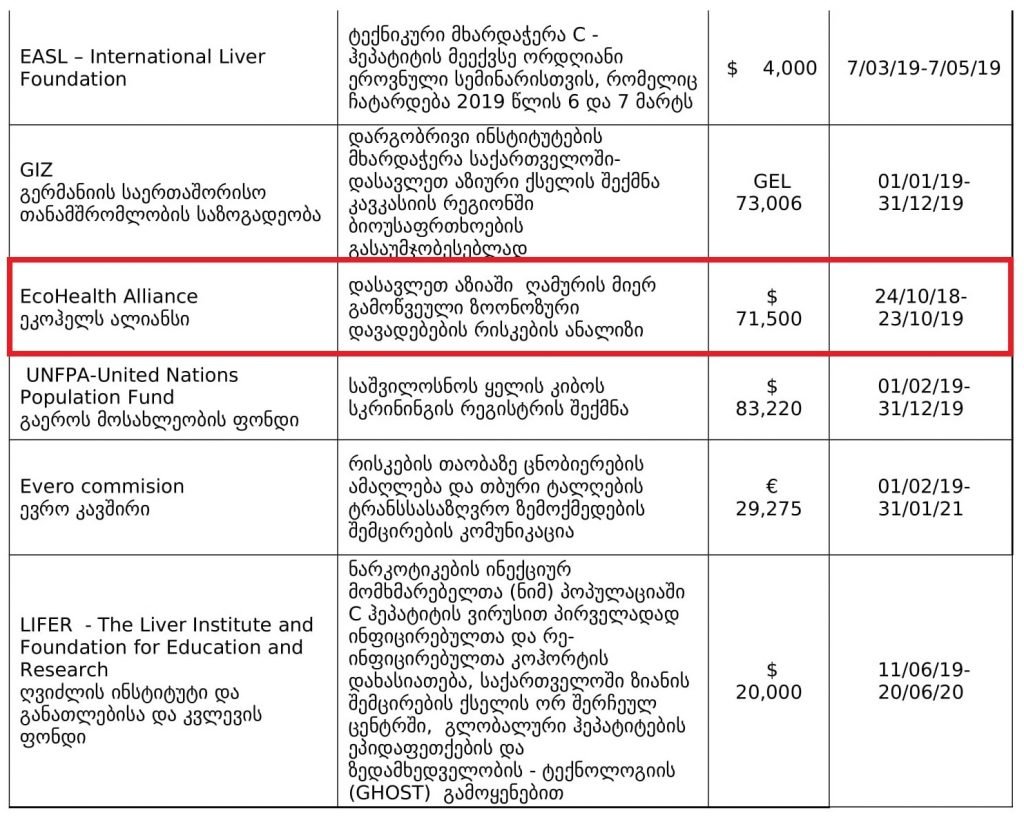
2. Bat Virus Database
Access to the database is limited only to those scientists participating in our ‘Bats and Coronaviruses’ project
Our intention is to eventually open up this database to the larger scientific community
https://t.co/mPn7b9HM48
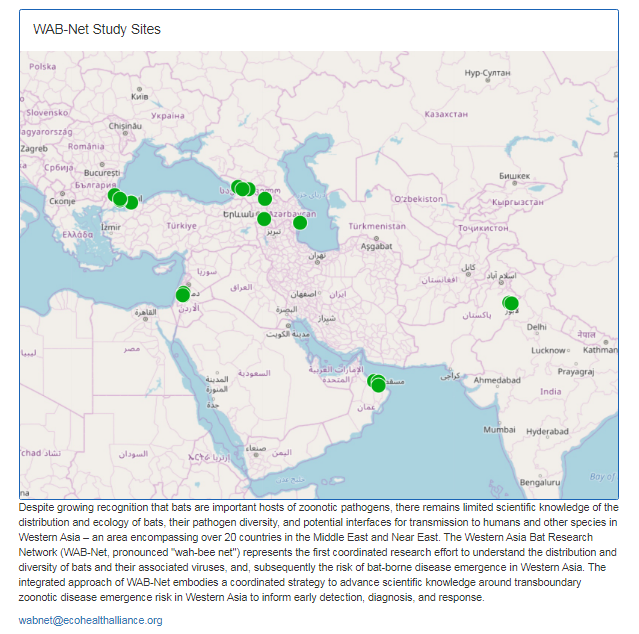
3. EcoHealth Alliance & DTRA Asking for Trouble
One Health research project focused on characterizing bat diversity, bat coronavirus diversity and the risk of bat-borne zoonotic disease emergence in the region.
https://t.co/u6aUeWBGEN

4. Phelps, Olival, Epstein, Karesh - EcoHealth/DTRA

5, Methods and Expected Outcomes
(Unexpected Outcome = New Coronavirus Pandemic)

Risks of bat-borne zoonotic diseases in Western Asia
Duration: 24/10/2018-23 /10/2019
Funding: $71,500
@dgaytandzhieva
https://t.co/680CdD8uug

2. Bat Virus Database
Access to the database is limited only to those scientists participating in our ‘Bats and Coronaviruses’ project
Our intention is to eventually open up this database to the larger scientific community
https://t.co/mPn7b9HM48

3. EcoHealth Alliance & DTRA Asking for Trouble
One Health research project focused on characterizing bat diversity, bat coronavirus diversity and the risk of bat-borne zoonotic disease emergence in the region.
https://t.co/u6aUeWBGEN

4. Phelps, Olival, Epstein, Karesh - EcoHealth/DTRA

5, Methods and Expected Outcomes
(Unexpected Outcome = New Coronavirus Pandemic)










